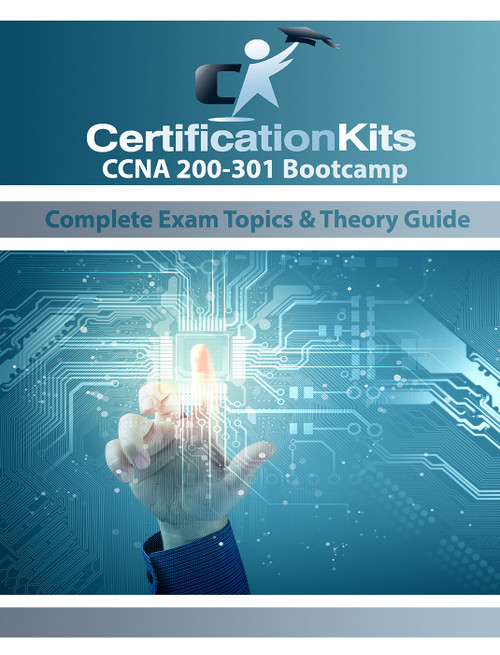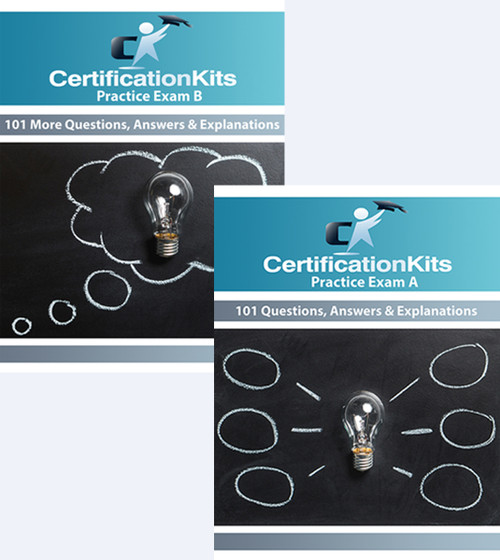CertificationKits CCNP ENCOR 350-401 Boot Camp & Theory eBook
Desktop & Mobile Compatible! IOS & Android friendly!
We are pleased to announce our new CertificationKits CCNP ENCORE 350-401 Boot Camp & Theory eBook! We know you will love our latest revision to our CCNP study guide that has been built upon through two decades of being an exceptional tool in the success of Cisco certification candidates. The CertificationKits CCNP ENCOR 350-401 Boot Camp & Theory eBook totals 999 pages of easy to read and understand content!
We have worked in collaboration with CCIEs and actual Cisco Netacad professors to ensure that we have the strongest match of knowledge meeting hands on experience with students. This was written by authors who not only know how to unlock students' capability to learn, but also know what it takes to beat that test! This CCNP study guide is 999 pages of power packed information written in an easy to understand format that maximizes your time and understanding! It not only follows the format of the new CCNP curriculum, but also works as a perfect companion to the Cisco Press CCNP ENCOR Lab Workbook.
With the latest revision of the CCNP curriculum, Cisco removed the prerequisite of having to hold a CCNA before you can take the CCNP. So, if you have some experience and are confident in your networking knowledge, you could use this as a starting point and go straight to taking the CCNP ENCOR exam! Once you complete CCNP ENCOR, you can move on to CCNP ENARSI to complete your CCNP Enterprise certification. CCNP ENCOR also serves as the core requirements for CCIE Enterprise.
With this release, we even took things a step further by upgrading to our new awesome eBook reader through LockLizard. This is the same engine that Cisco actually uses to protect and distribute their corporate documents. This makes it extra cool because it is a format you will see in the field as a working network engineer. This new ebook reader works on multiple platforms such as PC, MAC, IOS, Android, etc. We include 2 activations with each purchase so you can install it on a desktop AND a mobile device, for example. On top of that you can highlight, make notes and work directly with your document.
Please feel free to check out a demo of the first chapter of this our CCNA Theory eBook. This will give you a good feel for the new reader and format of our theory eBooks:
1. Download and install the LockLizard viewer for your IOS and device type from this link: LockLizard Viewer
2. Download and install the License file for the eBook: License File
(If you don't see it open, the window for the license file may pop-up behind your active windows)
3, Download and open the .Pdc eBook file: eBook File
The download and install is very straightforward and simple, but if you get stuck, please click here for a help guide on opening your eBook demo or official purchase. Upon purchase a unique license file and a .pdc file will be emailed to you,
Table of Contents:
Section 1: Switching
Chapter 1: VLANs & Trunking
VLAN Introduction
Trunking
Switch Port DTP Modes
Inter-VLAN Routing
VTP
Chapter 1: Questions
CHAPTER 1 RECOMMENDED LABS
Chapter 2: Spanning Tree Protocol
Spanning Tree & L2 Loops
STP Topology - Root Election
STP Topology - Designated Port Election
STP Port States
Traditional Spanning Tree Types
Chapter 2: Questions
CHAPTER 2 RECOMMENDED LAB
Chapter 3: Advanced Spanning Tree Protocol
STP Upgrades & Features
BPDU Guard
UDLD
Spanning Tree Configuration
BPDU Filtering Configuration
Rapid Spanning Tree Protocol (RSTP)
Multiple Spanning Tree Protocol (MST)
Chapter 3: Questions
CHAPTER 3 RECOMMENDED LAB
Chapter 4: EtherChannel
Introduction
EtherChannel Load Balancing
EtherChannel Negotiation Protocols
Chapter 4: Questions
CHAPTER 4 RECOMMENDED LAB
Section 2: Routing
Chapter 5: Routing Overview
IPv4 Explained
IP Routing
Routing Types
Static Route Types
Chapter 5: Questions
CHAPTER 5 RECOMMENDED LAB
Chapter 6: EIGRP
EIGRP Introduction
EIGRP DUAL
EIGRP Metric (K-Values)
Choosing Routes (cont.)
EIGRP Route Table
EIGRP load balancing
EIGRP Variance
EIGRP Reliability
Chapter 2: Questions
Chapter 7: OSPF
OSPF - Overview
OSPF Areas Concept
OSPF Terminology
OSPF DR and BDR Concept
Router ID (RID)
Types of OSPF Routers
Planning for OSPF
Configuring Single Area OSPF
OSPF Packet Types
OSPF Operational States
Link State Advertisements
Multiple Area OSPF
Summarizing Routes
Chapter 7: Questions
Chapter 8: Introduction to IPv6
IPv4 Concerns
IPv6 Header
IPv6 Address Structure
IPv6 Address Scope Types
IPv6 Unicast Addressing
IPv6 Multicast
IPv6 Anycast
Other IPv6 features
IPv6 Routing Protocol Considerations
Chapter 8: Questions
Chapter 9: BGP
BGP Basics
BGP Databases
BGP Routing Process
Activating BGP on a Router
Injecting Routes into BGP
BGP Split Horizon
Route Synchronization
BGP Summarization
BGP Verification Commands
BGP Neighbor states
Simple BGP Example
BGP Attributes
Path Selection
AS-PATH
Next Hop Attribute
Mutli Exit Discriminator
Local Preference
WEIGHT
Chapter 9: Questions
Section 3: IP Services
Chapter 10: Foundation Topics
Time Synchronization
Network Time Protocol
Chapter 10: Questions
Chapter 11: Network Address Translation (NAT)
NAT Overview
Static NAT
Dynamic NAT
PAT
Chapter 11: Questions
Chapter 12: First Hop Redundancy Protocols
Introduction
HSRP
HSRP States
More HSRP parameters
VRRP
Gateway Load Balancing Protocol
Cisco NSF with SSO
Cisco StackWise
Chapter 12: Questions
CHAPTER 12 RECOMMENDED LAB
Chapter 13: IP Multicasting
Fundamentals
Multicast Advantages
Multicast IP Addresses
Protocols Used for Multicasting
Internet Group Management Protocol
Multicast Routing Protocols
Protocol-Independent Multicast (PIM)
Dense Mode
Sparse Mode
Rendezvous Point – RP
Chapter 13: Questions
Chapter 14: QoS
QoS - Introduction
Parameters for Quality of Service
Putting Quality of Service into Practice
QoS mechanisms
Tools for Quality of Service
QoS Traffic Policing Explained
Chapter 14: Questions
Section 4:Security
Chapter 15: Device Access Control & Security Devices
Telnet
SSH
Securing Management Access
Authentication
Authorization
Accounting
802.1x Port-Based Authentication
Zone Based Firewall
Cisco IOS Firewall
Chapter 15: Questions
Chapter 16: VPN
VPN
VPN -Types
VPN- Logical Topologies
GRE - Site to Site Tunnels
Dynamic Multi Point VPN
DMVPN – Protocols
IPSec
IPSec Security Services
IPSec - Modes
Chapter 16: Questions
Chapter 17: ACL
Introduction
Standard ACL
Extended ACL
Named ACL
Rules for Using the Access List
Creating IP Access Lists: Some Pointers
Benefits of IP Access Lists
Chapter 17: Questions
Section 5: Wireless
Chapter 18: Wireless Infrastructure
Introduction
Wireless LAN
SOHO WLAN
Enterprise WLAN
Coverage of Wireless Antennas
Chapter 18: Questions
Chapter 19: Authenticating Wireless Clients
Wireless Authentication Methods
1. Open Authentication
2. WEP
3. EAP
Chapter 19: Questions
Section 6: Architecture
Chapter 20: Enterprise Network Architecture
Cisco Hierarchical Network Design Model
Collapsed Core Approach
Campus Flow Classification
Chapter 20: Questions
Chapter 21: Fabric Technologies
SD-Access
SD-Access Network layer
SD-Access Network Underlay
SD-Access Fabric Overlay
SD-WAN
vManage
vBond
vSmart
vEdge
Chapter 21: Questions
Chapter 22: Network Assurance
Network Troubleshooting Tools
NetFlow
SPAN and RSPAN
IP SLA
Cisco DNA
NETCONF and RESTCONF
Chapter 22: Questions
Section 7: SDN
Chapter 23: Virtualization
Cloud Computing (Overview)
Virtualization (Overview)
Server Virtualization
Hypervisors
Advantages of Virtualization
Containers
Virtual Switches
The Complexity of Network Virtualization
Chapter 23: Questions
Chapter 24: Network Programmability
Introduction to Python
JSON Data Format
YAML Data Format
XML Data Format
APIs – Introduction
Intro to REST API
URI, URN, and URL
Chapter 24: Questions








